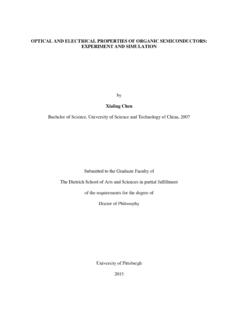Transcription of Topical review Optical properties of III-Mn-V ...
1 Topical reviewOptical properties of III-Mn-V ferromagnetic Burcha, , Awschalomb, BasovcaDepartment of Physics, University of Toronto, Toronto, Ontario, Canada M5S 1A7bDepartment of Physics, University of California, Santa Barbara, CA 93106, USAcDepartment of Physics, University of California, San Diego, CA 92093-0319, USAarticle infoArticle history:Received 21 February 2008 Received in revised form21 July 2008 Available online 15 August 2008 Keywords:Magnetic semiconductorOptical propertyMetal to insulator transitionabstractWe review the first decade of extensive Optical studies of ferromagnetic, III-Mn-V diluted magneticsemiconductors.
2 Mn introduces holes and local moments to the III V host, which can result in carriermediated ferromagnetism in these disordered semiconductors . Spectroscopic experiments providedirect access to the strength and nature of the exchange between holes and local moments; the degreeof itineracy of the carriers; and the evolution of the states at the Fermi energy with doping. Takentogether, the diversity of Optical methods reveal that Mn is an unconventional dopant, in that the metalto insulator transition is governed by the strength of the hybridization between Mn and its p-nictogenneighbor.
3 The interplay between the Optical , electronic and magnetic properties of III-Mn-V magneticsemiconductors is of fundamental interest and may enable future spin-optoelectronic Elsevier All rights IntroductionFor more than two decades the study of magnetic impuritiesin semiconductors has received a great deal of attention(see Refs.[1 7]and references therein). The interest in thesecompounds is driven in part by the desire to utilize the spindegree of freedom in electronics[8 10]. This rapidly expandingfield of spin based electronics (spintronics) has exploited metalbased devices to bring about a revolution in magnetic sensors andcomputer hard drive density[11].
4 The discovery of ferromagnet-ism in III V hosts heavily doped with Mn has launched a newphase in magnetic semiconductors research in part because of thehigh promise of III-Mn-V systems in the context of spintronicsapplications. The unique advantage of III-Mn-Vs is that magnetic, Optical and electronic effects are all interconnected. Furthermore,all these properties are sensitive to external stimuli and can bereadily modified by the application of external electric ormagnetic field and also by illumination with light. Inherenttunability of (ferro)magnetic semiconductors is of high interest inview of novel magneto- Optical device functionalities.
5 Since opticaltechniques are well suited to create, measure and manipulatespins in semiconductors [12 18]the systematic investigation ofoptical properties of III-Mn-V materials promises to uncover newavenues for applications of ferromagnetic semiconductors byoffering insights into the fundamental physical processes in semiconductors also pose a number of uniquechallenges to understanding the physics governing their proper-ties. In addition to the standard difficulties with separatingelectron electron interactions from disorder effects[19], mag-netic dopants result in additional states in the band structurewhose description is non-trivial[20].
6 Nonetheless they alsoprovide a rare opportunity to study the connections betweenband structure, carrier dynamics and magnetism in a well-controlled environment. Initially this work focused on II VIcompounds and very dilute concentrations of transition metals(TM) doped into III V semiconductors [1,2,6,21,22]. Research onthese diluted magnetic semiconductors (DMS) was limited by thedifficulty in doping carriers into II VI compounds and the lowconcentration limit for TM in III V materials[6]. The origin of thelimit in III V semiconductors lies in the different lattice structuresfor the end members, namely zinc-blende or wurzite for III Vcompounds and hexagonal for TM-V materials[23].
7 Nonethelessthis limitation has been overcome via growth under non-equilibrium conditions[24,25], resulting in a wide variety ofIII-TM-V compounds and heterostructures (including superlatticesand quantum wells) that exhibit magnetic order and can be tunedthrough their metal to insulator transition (MIT).This advance has opened up a large array of possibleapplications for ferromagnetic III-Mn-V materials and led to anenormous amount of research. Despite the substantial progressover the past decade, there are still a number of open questions inthis field. In particular, the proper theoretical framework todescribe the ferromagnetism that emerges in many III-TM-Vmaterials still remains elusive[3,7,26 39].
8 The answer to thisfundamental question has been hindered by a lack of consensusARTICLE IN PRESSC ontents lists available atScienceDirectjournal of Magnetism and Magnetic Materials0304-8853/$-see front matter&2008 Elsevier All rights Corresponding ( Burch).Journal of Magnetism and Magnetic Materials 320 (2008) 3207 3228about the evolution of the electronic structure of III-TM-Vcompounds with TM doping. A goal of this review is to offer thereader an in-depth discussion of this fundamental, yet contro-versial issue. In this vain, we have based our discussion on theinformation that has emerged from a variety of spectroscopicexperiments with an emphasis on data generated throughextensive Optical studies of III-Mn-V techniques have established themselves as providingkey insights into the band structure of materials.
9 In fact, theelectronic structure of many semiconductors has been determinedby comparing theoretical calculations to Optical results[40].Furthermore, as summarized inFig. 1, Optical techniques cover abroad range of energy scales in magnetic semiconductors . Inaddition, Optical studies have provided a unique view into theunderlying physics governing various correlated electron materi-als[41 45]. Similar to these systems III-TM-V semiconductors alsoexhibit an interplay between their magnetic properties , carrierdynamics and band structure. Interestingly in III-TM-V DMS thecarriers originate from the magnetic ions but also mediate thelong-range magnetic interaction by traversing the host arises from the mixing of the local moments with extendedstates.
10 In fact, this hybridization between p and d orbitals is whatdistinguishes III-TM-V compounds from semiconductors dopedwith non-magnetic better understand the effects of magnetism on the bandstructure of III V semiconductors (and vice versa) extensiveoptical studies have been applied to III-Mn-V ferromagneticDMS. As detailed throughout this review , magneto-opticalexperiments have demonstrated the ferromagnetism originatesfrom a single III-Mn-V phase and not from inclusions, such asMn-V in a III V matrix. Furthermore, magneto- Optical measure-ments have provided a determination of the strength of thehybridization between the Mn local moments and holes thatmediate the magnetic state[2,3,22,46,47].









